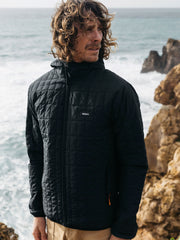On the way home we headed to a forest-backed beach that was tucked in the corner of a wide bay. The swell had risen dramatically from the day before and we required shelter. At first the waves seemed too small. But after further consideration, and a delicate recalibration of our expectations, we started to see wedges and zipping peaks created by the refractions within the tight cove. By this point we had been joined by Portuguese surfer Ria; as adept on a shortboard as she is elegant on a longboard she quickly got to work hunting down the elusive side waves. Surfing inside a bay or estuary is a special experience. With no sight of open ocean it feels as if you are tricking nature, defying the laws of the planet. Although the waves weren't of the highest quality the surf itself was a memorable one punctuated with diving gannets, shafts of celestial light and a glimpse of an otter.
Compared to the renown of Finisterre, Faro de Punta Nariga is barely visible. Even in the internet age of boundless knowledge, information on the lighthouse is scarce, limited to a handful of Spanish sites that mention it only briefly. For all Finisterre's cultural importance it feels as if it may have fallen foul of its own significance and as a result is daubed with the many trinkets of tourism. Faro de Punta Nariga could not be more different. The lighthouse stands imposing and alone at the end of its geographical namesake. Free of the meaning of the points of a compass it exists in glorious obscurity. Water whips off the bronze statue that stands at the point of the lighthouse's triangular base, it is gnarled and alive, a humanoid form lunging fearlessly at its lonely corner of ocean. The surrounding rocks fragment beneath our hands and twist and slide beneath the geometric brutality of the lighthouse. Sculpted by the elements it is as if the sea has crawled onto the land, petrified waves breaking for eternity. Punta Nariga acts as a reminder that one's own land's end can be anywhere. Finisterre possessed undeniable majesty but Nariga felt just as powerful.
Our final day saw us exploring not the edges of the land but deep inside an estuary. Where the Rio Mandeo flows into the sea, just past the Puente de O Pedrido, it forms a narrow bank of sand over which, during massive winter swells, long clean waves can break. It was here during one such massive swell where we shared a final surf. We each tackled the long paddle out and were rewarded with lengthy, sloping rides. The swell was a precursor to the return of winter. The day after we left the storms rolled back over Galicia and the town of Caión was once again buffeted by a haze of Atlantic salt.

















































































